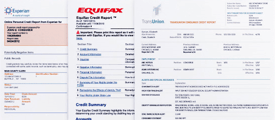

You’ve probably been told that filing for bankruptcy isn’t the worst option, but it should probably be your last option. This is very true. Filing for bankruptcy isn’t an easy decision.
While bankruptcy can protect you from your creditors when you’re facing a financial disaster, it will almost certainly wreck your credit reports as a consequence of that relief.
Filing for bankruptcy doesn’t have to be the end of your story. It is possible to recover from bankruptcy, and it may not take as long as you would think. With the right plan in place, you can start rebuilding your credit for future use. That plan starts by executing a few proven tips for recovering from bankruptcy.
1. Check Your Three Credit Reports
When you file bankruptcy, the credit bureaus will likely update your credit reports in a variety of ways. First, a record of the bankruptcy filing itself will likely be added to the “Public Records” section of your credit reports.
Next, the credit bureaus will update the actual debts included in your bankruptcy to indicate the debt is subject to bankruptcy protection. With both Chapter 13 and Chapter 7 bankruptcies, the debts involved should be updated to indicate “included in bankruptcy.”

You can check all three of your consumer credit reports for free once a year at annualcreditreport.com.
Once the bankruptcy is discharged, the debts may be updated again to indicate “discharged in bankruptcy.” Chapter 7 bankruptcies are typically discharged within only a few months after filing, while Chapter 13 bankruptcies can take several years to discharge, as you’ll be making payments to the bankruptcy trustee.
The practice described above is what is supposed to happen to your credit reports when you file for bankruptcy. It’s up to you to check your three credit reports from Equifax, TransUnion, and Experian to make sure your debts are updated correctly. You can do this for free at annualcreditreport.com.
If you discover a debt that was included in your bankruptcy isn’t being reported, you should let the credit bureaus know right away. You can submit a dispute to the credit bureaus and include your bankruptcy paperwork to support your claim. This is normally an easy item to have corrected and shouldn’t take more than a few weeks and is a free service.
2. Establish New Credit
Another important step to take after filing bankruptcy is to establish new credit accounts. These new accounts won’t erase the negative information on your credit reports, of course, but they can potentially be a step in the right direction toward future credit improvement.
Despite what many people believe, establishing new credit after a bankruptcy is possible if you keep your expectations realistic. No, you may not qualify for a premium rewards credit card right away, but you’re much more likely to qualify for certain types of accounts after your bankruptcy.
Types of credit you may consider after bankruptcy include:
Secured Credit Cards
You’ll be asked to make a cash deposit with the credit card issuer. The credit limit of your card will be equal to, or very close to, the amount of your deposit. If you don’t make your payments and go into default, the card issuer already has your money and can use that deposit to pay your debt.
Below are three secured credit accounts to consider.
- No credit check to apply
- Adjustable credit limit based on what you transfer from your Chime Checking account to the secured deposit account
- No interest* or annual fees
- Chime Checking Account and qualifying direct deposit of $200 or more required to apply. See official application, terms, and details link below.
- The secured Chime Credit Builder Visa® Card is issued by The Bankcorp Bank, N.A. or Stride Bank, N.A., Members FDIC, pursuant to a license from Visa U.S.A. Inc. and may be used everywhere Visa credit cards are accepted.
- *Out-of-network ATM withdrawal and OTC advance fees may apply. View The Bancorp agreement or Stride agreement for details; see back of card for issuer.
| Application Length | Interest Rate | Reports Monthly | Reputation Score |
|---|---|---|---|
| 5 minutes | N/A | Yes | 9.5 |
- New feature! Earn up to 10% cash back* on everyday purchases
- No credit check to apply. Zero credit risk to apply!
- Looking to build or rebuild your credit? 2 out of 3 OpenSky cardholders increase their credit score by an average of 41 points in just 3 months
- Get free monthly access to your FICO score in our mobile application
- Build your credit history across 3 major credit reporting agencies: Experian, Equifax, and TransUnion
- Add to your mobile wallet and make purchases using Apple Pay, Samsung Pay and Google Pay
- Fund your card with a low $200 refundable security deposit to get a $200 credit line
- Apply in less than 5 minutes with our mobile first application
- Choose the due date that fits your schedule with flexible payment dates
- Fund your security deposit over 60 days with the option to make partial payments
- Over 1.4 Million Cardholders Have Used OpenSky Secured Credit Card To Improve Their Credit
- *See Rewards Terms and Conditions for more information
| Application Length | Interest Rate | Reports Monthly | Reputation Score |
|---|---|---|---|
| 9 minutes | 25.64% (variable) | Yes | 7.0/10 |
- 1% Cash Back Rewards on payments
- Choose your own credit line - $200 to $2000 – based on your security deposit
- Build your credit score.¹ Reports to all 3 credit bureaus
- No minimum credit score required for approval!
- ¹ Cardholders who keep their balance low and pay their credit card bill on time every month typically do see an increase in their credit score.
| Application Length | Interest Rate | Reports Monthly | Reputation Score |
|---|---|---|---|
| 9 minutes | 19.24% (V) | Yes | 7.5/10 |
Credit Builder Loans
Credit builder loans are small-dollar loans issued by banks and credit unions. These loans, often for no more than $1,000, are designed to be paid back over a period of six to 12 months with the payments reported to the credit reporting agencies.
Authorized User Status on a Credit Card
An authorized user is someone whose name is added to the existing account of another person. The authorized user has no liability for the payments but will benefit from the credit reporting of the card to the three credit reporting agencies.

Keep in mind, if you discharged a debt with a specific card issuer or lender, you probably won’t get approved for new credit from the same company again. Lenders and card issuers tend to have long memories. Instead, you’ll probably be better off applying with card issuers and lenders that weren’t subject to your bankruptcy.
3. Master the Credit Score Basics
Bankruptcy and the events that lead to bankruptcy (late payments, collections, defaults, etc.) can often inflict serious damage to your credit scores. It’s a good idea to learn what influences those important numbers if you hope to rebuild your credit scores.
The following factors matter to most FICO and VantageScore credit scoring systems, the two most commonly used credit score models in the United States.
- Your payment history. On-time payments are essential on all newly opened accounts if you want to start improving your credit scores. You’re judged more harshly as a bankruptcy filer, so even a few late payments could slow any progress.
- The credit utilization of your credit cards. You should aim to pay your credit card balances in full each month to save money on interest fees. If you can’t, however, you should keep your balances as low as possible.
- A healthy mix of account types. Scoring models reward you when you have a mixture of revolving accounts (e.g. credit cards, home equity lines of credit, etc.) and installment accounts (e.g. personal loans, mortgages, auto loans, etc.) on your credit reports. Just remember to make your payments on time regardless of the type of accounts you open.
Being cognizant of these factors and how they affect your credit scores is an important first step in rebuilding your credit.
4. Be Patient
Filing for bankruptcy can protect you from collection efforts and even from being sued by your creditors when you can’t afford to pay your debts. But a bankruptcy won’t erase negative accounts or payment histories from your credit reports. Only time will do that.
Most negative information must be removed from your credit reports after no longer than seven years, per the Fair Credit Reporting Act (FCRA). Late payments, defaults, and collections, for example, fall into this category.

With respect to collection accounts, those must be deleted from credit reports no later than seven years from the date of the first delinquency that led to the default of the original underlying account, not from the date the account was assigned to the collection agency.
Even your bankruptcy itself has an FCRA-mandated time limit with regard to credit reporting. A Chapter 7 bankruptcy can remain on your credit report for up to 10 years from the date it was filed. Chapter 13 must be removed no later than seven years from the date of its discharge, or 10 years from the filing date — whichever occurs first.
But even though the negative information may hang out on your credit reports for years, the impact it has on your credit scores changes over time. The older a bankruptcy and any discharged debts on your credit reports become, the less your credit scores will be affected.
Remain Realistic, But Hopeful
Recovering from bankruptcy isn’t easy and it won’t happen overnight. There simply isn’t a silver bullet solution. But you should also not accept that your credit will be permanently damaged after a bankruptcy, either. That simply isn’t true.
You can follow these tips for recovering from bankruptcy and build a solid plan that involves establishing positive credit and managing it well. Next, continue to track your three credit reports for progress and accuracy. Little by little, you could begin to see the post-bankruptcy recovery reflected in your credit scores and your credit offers.
Advertiser Disclosure
BadCredit.org is a free online resource that offers valuable content and comparison services to users. To keep this resource 100% free for users, we receive advertising compensation from the financial products listed on this page. Along with key review factors, this compensation may impact how and where products appear on the page (including, for example, the order in which they appear). BadCredit.org does not include listings for all financial products.
Our Editorial Review Policy
Our site is committed to publishing independent, accurate content guided by strict editorial guidelines. Before articles and reviews are published on our site, they undergo a thorough review process performed by a team of independent editors and subject-matter experts to ensure the content’s accuracy, timeliness, and impartiality. Our editorial team is separate and independent of our site’s advertisers, and the opinions they express on our site are their own. To read more about our team members and their editorial backgrounds, please visit our site’s About page.







